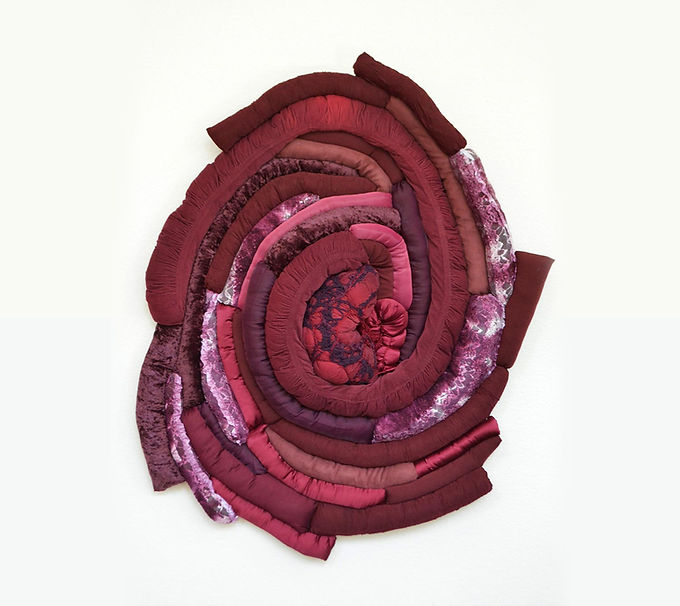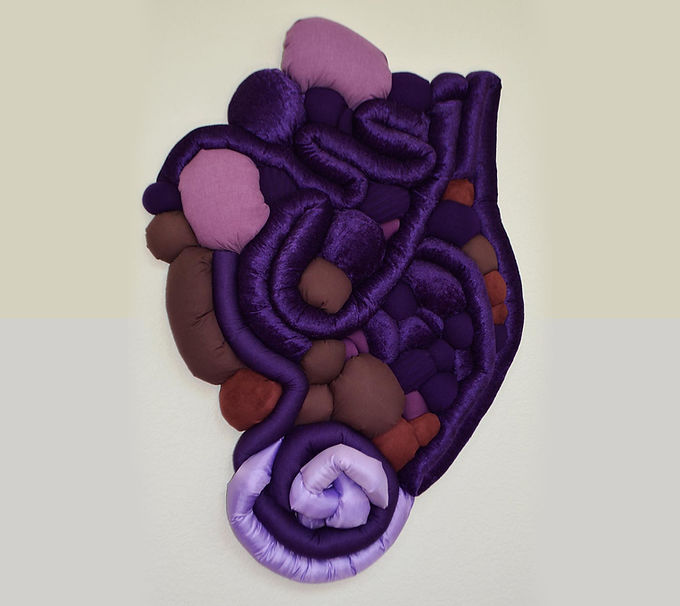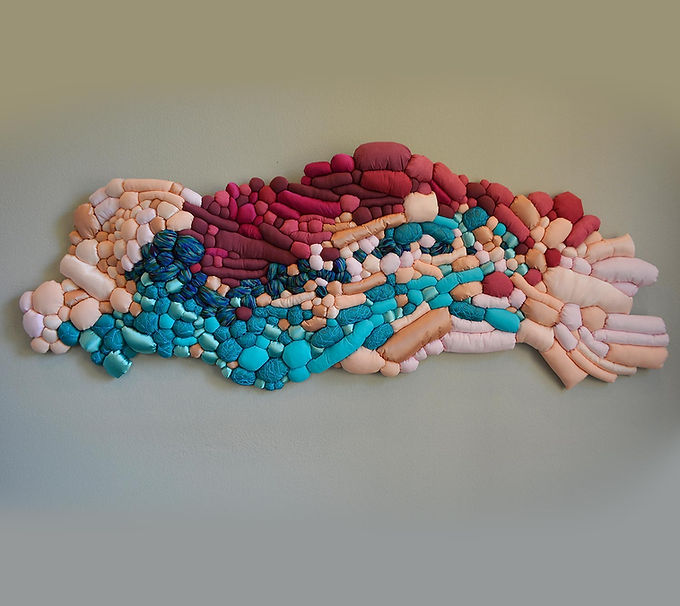
Mônica Lóss
In my work, I explore textile materials and procedures to produce constructions, sensory and wearable objects that relate to space as a way to produce photographs, performances, videos and installations.
I investigate the ritualistic dimension of manual crafts as a practice of individual and collective reinvention, I create fables about territories, bodies and other natures. I am interested in delving into the genealogy of identities that arise from the sense of not belonging triggered by immigration processes.
My work lives in the practice of collecting insignificances, detachments and accumulations, interested in the memory load of these materialities and as a strategy to interfere in the destiny and permanence of things in the world.

Where Does the Hunger of the Word go?
About the installation
Where Does the Hunger of the Word go? is a series of works that I started in 2022 in which I researched the deep relationship between identities, resilience and immigration processes of Latin American immigrant women; using pieces of clothing as an element that connects memory and transformation, I generated a form of art that created new narratives based on their original personal stories.
In this series of works, I have used various textile procedures such as sewing, crochet, embroidery and artisanal dyeing/coloring to produce pieces with varying dimensions that move between two- and three-dimensional. But this series isn't just about technique; it is an in-depth exploration of issues related to the identity, immigration, and resilience of Latin American immigrant women, including my own journey of immigration (from Brazil to the United States) and migration (Michigan, Texas, and California) in the United States.
Many of the fabrics used in the construction of the series' pieces are clothes donated by women from different Latin American countries who have immigration as a common experience. The clothes act as a testament to the diverse journeys and intricate stories; a link between the past and the present, forming a new landscape for the new times we face.
Women's immigration processes are a central point of interest in this series. They represent much more than a simple geographic displacement; they resonate as a way to search for a place in the new land, resilience in the face of adversity and constant reinvention of oneself. Transforming what was once clothes into part of something new becomes a path of inner healing, of rebuilding the empty spaces that crossings, losses and ruptures cause. It becomes a tool to explore the relationship that is established between being and belonging to a new place.
The construction of the title of this research Where Does the Hunger of the Word go? occurred little by little, through events, experiences and personal symbolisms that I have been experiencing as a “Latin-Brazilian” female artist based in the United States. But mostly, it expanded and gained consistency as I connected with other women's stories. The clothes that were donated for the production of the first works in this series arrived accompanied by stories and memories that the clothes held for these women. Some of the stories they told about the clothes were related to their places of origin, to a love, to a longing, to a loss, to a joy... these experiences evoked through the donated clothes became questions, they became voices belonging to a collective. In the first instance, “Where Does the Hunger of the Word go?” may lead to the idea that the works can deal with hunger in the literal sense, but in fact, what is sought here is to give clues that evoke the notion of what it means to have needs, basic needs that are not met, such as hunger, for example, as well as experiencing inequalities, inequities, violence, precariousness and oppression, especially from the perspective of the lives of immigrant women. These are wounds that need to be healed, healed, just like hunger.

Bio
PhD in Arts and Education by the University of Barcelona, Spain, Master in Education, postgraduate in Surface Design by the Federal University of Santa Maria, Brazil and by the same institution, she holds a bachelor's degree and a teaching degree in Visual Arts.
She is a member of the group of women artists Gomagroupa (BR), is a researcher in the Group Dissident Experiences in Visual Arts – Federal University of Amapá (BR). She has participated in exhibitions in differents institutions in Brazil, United States, Mexico and Europe such as: Embassy of Brazil in Stockholm, Sweden; KORU6, Helsinki, Finland and Galerija ARgenTUM, Vilnius, Lithuania (2018). Her work was selected for the “97th Annual All Media Exhibition”,Ann Arbor Art Center, MI, USA (2019); “Deep Blue See show”. Ground Floor Gallery, NY, USA (2020), “Mostra Museu: Art in the quarentine”, SP, BR (2021); “In Praise of Magic”, Paradice Palase, Brooklyn, NY (2021); Manufactured Narratives: Chronicles of Textile Artists. UICA, Grand Rapids, MI, USA (2022). New York Latin American Art Triennial. Queens College Art Gallery / Kupferberg Center for the Arts. NY, USA (2022); Maskoletânea. Espaço Piloto Gallery. UNB, Brasília, Brazil (2023); Tenuous Threads. Atlantic Gallery, NY (2023); Entrelinhas, Oficina Cultural Oswald de Andrade, SP, BR (2023). Also noteworthy are the solo exhibition “Offerings” at “Cluley Projects Gallery”, Dallas, TX (2023) and the “New futures Award”, The Other Art Fair, Dallas, TX, USA (Spring 2023).











